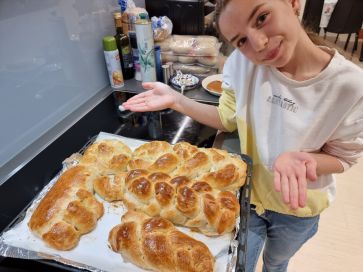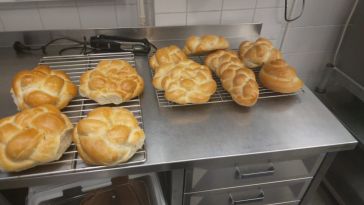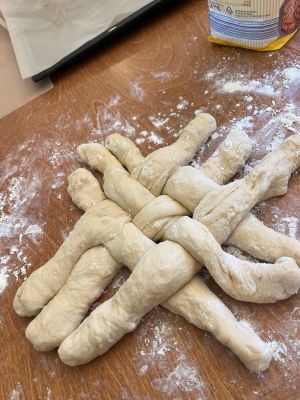Challah bread in the Jewish culture
| Challah bread in the Jewish culture | ||||
|---|---|---|---|---|
|
Practitioners and people who know the tradition well

Challah is an important part of Jewish culture all over the world. The observant Jews eat challah on Shabbat and on Jewish holidays. There are roughly 1200 Jews who are members of the Jewish congregations of Helsinki and Turku, and it is estimated that in total there are around two thousand Jews in Finland - including those who are not members of any congregation. Many Jews in Finland who consider themselves less, or non-observant, will still eat challah on many occasions, even every week. Because fresh and kosher challah is not available in stores in Finland, it is often baked at Jewish homes, usually by women, and eaten at home by the whole family. Challah is also baked in the Jewish communities of Helsinki and Turku and sometimes women gather to bake challah together in women-circles or through associations and organizations such as Wizo, Fruntta and Chabad. Every Friday, children bake and eat Challah at the Jewish School and day cares.
Practising of the tradition
Challah is usually made of white flour, sugar, yeast, oil, water and eggs. Challah is reminiscent of the Finnish ‘pullapitko’ however challah is less sweet and prepared without milk. The distinction in sweetness is important for Sephardic Jewish tradition, because a bread that is too sweet could be considered a cake, and thus unfitted to be considered challah.
Challah has various names and adaptations in different communities. In Finland it is often also called chale, chala-leipä or chalapulla, which is a combination of the Hebrew word and the Finnish word ‘pulla’, commonly used with children. Most of the people in the Jewish community of Helsinki use the same challah-recipe: Haras’s challah recipe, which is also used in the community kitchen. This recipe has a unique local adaptation- of adding cardamom, although most households prepare challah without it. There is also a recipe that originates from Turku, that suggests adding Koskenkorva. That is not commonly used, but an examination of the recipes shows that the culinary tradition is the same.

For challah to be ritually acceptable a small portion of the dough needs to be set aside as an offering. This act is called separating challah (‘hafrashat challah’). And the offering itself is also called ‘challah’.
The challah dough is usually divided into strands and braided before being baked. Braiding styles, decoration and level of elaboration can vary. There are traditions of braiding challah in different shapes for certain occasions, such as a round challah with raisins for Rosh Hashanah to symbolize the never-ending cycle of the seasons, or a key shaped challah called ‘shlissel’ which is eaten on the first Shabbat after Pesach- as a symbol for good fortune. The Shabbat meal, which is eaten by Jews on Friday night, as well as most holiday dinners, require there are two loaves of challah - regardless of what the meal consists of. The loaves are often placed on a designated board or plate and are covered with a challah cover- a piece of cloth which may be decorated with embroidered ornaments, sometimes in gold and silver. Some people also use a special knife, which is only used to cut challah.
After blessing the wine, family members will wash their hands. It is a custom not to speak between washing the hand and the blessing of the challah. Then the challah-cover is removed, the two challah loaves are held together and the head of the family recites a blessing. Afterwards the challah is either cut or torn (there are varying traditions), salted and divided to members of the household.
The background and history of the tradition

The term challah comes from the Hebrew bible, where it describes a “loaf” or a “cake”. It is first mentioned in a verse which commands to separate part of the dough to be set aside as donation for the Kohen (priest), where the separated piece is referred to as a "challah" (Numbers 15:19-20).
Challah as it is commonly eaten in Finland, is an eastern-European tradition, which has been brought in the early 1800’s with the so-called ‘Cantonists’-Jewish soldiers who were enlisted, often as minors, to serve in the Czar’s army for as long as 25 years. They were the first Jews known to permanently settle, and form congregations in Helsinki, Turku and Vyborg.
After completing their service, the ‘cantonists’ were permitted to settle with their families in the towns where they served. This enabled them to stay in Finland at a time when Jews were otherwise prohibited by law from settling in the autonomous Grand Duchy of Finland. Despite a lack of civil rights, a threat of expulsion and many restrictions they faced, the cantonists held tightly to Jewish religion and traditions- which ensured their survival.
Today many Jews in Finland are descendants of later migrations, they have diverse backgrounds and traditions, yet challah traditions are usually fairly similar for Jews around the world.
The transmission of the tradition
Most people have early memories of challah from home, involving parents and grandparents. The tradition is often transmitted within the family as part of a broader Jewish upbringing. Recipes can be shared between family members and friends: meals are enjoyed together.
Congregations and associations are also important in passing on Jewish knowledge and traditions. They are enablers of Jewish life and places where connections are formed around the traditions. Challah is baked in the Jewish community kitchens, eaten in communal meals and children who attend Jewish education get to bake, bless and eat challah in the day cares and schools. Organizations such as Chabad, actively encourage Jews to participate in and learn traditions, by organizing events and gatherings.
The future of the tradition
Today, for many Jews in Finland religion and tradition plays a less significant role in their lives than in previous generations. Traditional Jewish dishes are often consumed only on holidays, except for challah, which is still eaten on Friday evenings by many Jews. Food is the strongest and often the only link to the Ashkenazi Jewish roots of the community members, and festive meals offer a possibility to preserve these roots.
At the same time, new trends are driven by the internet, which enables Jews, especially the youth, new ways to connect and feel a part of global trends and integrate Judaism in contemporary lifestyles. They adapt and explore fun trends such as baking rainbow coloured challah for the week of Noah’s torah portion, share memes, and follow Instagram accounts with baking and braiding tips.
For the tradition to continue it is important to be able to sustain Jewish life as a whole on a personal and communal level. Congregations around the world are being challenged by declining member numbers, aging population and secularization.
The community/communities behind this submission
WIZO Finland (Women’s International Zionist Organization; is a volunteering international politically unengaged women's organization working for women and children in Israel.)
Fruntta,(JudiskaFruntimmers Välgörenhetsförening; a charitable foundation founded by Jewish women in 1898.)
The article was born as part of the project of Ambassadors of Living Heritage in 2023 and was written by Shani Armon
Bibliography and links to external sources of information
Internet sources
Pataricza, Dóra, Challahpulla NJ Where two wor(l)ds meet
Litterature
Haras, Rina, Suomen juutalaisten perinneruokia (Helsinki, Judiska Fruntimmers Välgörenhetsförening) 2006.
Kadimah Suomen juutalaisten historia, Taimi Torvinen, Otava 1989, ISBN 951-1-10951-0
LeChaim – Kuvia Suomen juutalaisten historiasta. Karisto Oy Kirjapaino 2006, s. 154
Videos and pictures
